


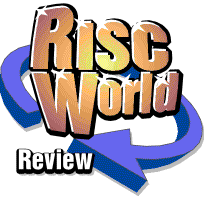
Ovation Pro CD Edition
Geoffrey Dean evaluates the new CD-based release of the foremost RISC OS desktop publishing package, Ovation Pro

Until last year, Ovation Pro was published by BEEBUG Ltd, but around six months ago its ownership passed to its original author, David Pilling. The new CD-ROM-based version 2.6 release under review here is the first major upgrade since the change of hands, and represents a very important advance on version 2.52, which was the last to be published by BEEBUG.
In this review I'm going to be looking at the broad facilities of Ovation Pro itself, for the benefit of those readers who haven't yet taken the plunge and bought it at all; but I'll also be looking at what you get on the CD itself, for the benefit of those readers who are interested in upgrading from a previous version. If you've got the BEEBUG edition of Ovation Pro already, you might like to skip the following section and jump straight to the information about the CD upgrade.
Overview of Ovation Pro
Ovation Pro was designed from the outset to be the most advanced desktop publishing package available for RISC OS, and there's little doubt that it achieves that aim; indeed, it's one of the most powerful DTP packages available on any platform. Among its more important attributes and supported features are the following:- A modular design with extensible functionality
- Highly customisable, with full script language and editable button bar etc.
- Multi-level undo and redo
- Retro-active master pages
- Comprehensive named text style system, supplemented by local effects
- Many complex typographic controls, including editable hyphenation and justification rules
- Supports multi-column, rotated and irregular frames
- Automatic flow of text around graphics
- Extremely comprehensive printing options, with imposition support
- Powerful colour system with named colours and processing effects
- Full PostScript support, with individual screen settings available for all images
- Allows the use of proxy images
The list above is, of course, just a taster of the more important features that the package offers. In fact, the range of facilities it provides is so extensive that it would be totally impractical to try to describe them all in a review such as this, so I'll just run through the more important aspects of what it can do. I ought perhaps to say from the outset that Ovation Pro is definitely one of my favourite RISC OS applications. Having used it constantly since 1996 to produce documents ranging from simple black and white posters to full-colour magazines, I've obviously had a lot of experience with it; and yet, even now, there are plenty of features that I've never needed to use at all! That isn't to say that it's Windows-style bloatware; it's just an extremely comprehensive piece of software. I'm also quite experienced in the use of Impression, QuarkXPress and Adobe InDesign, and I can say with certainty that Ovation Pro is easily my favourite of all of these.
So, let's run through some of the basics of what the package can do. If you're reading this because you don't have Ovation Pro already, then the chances are that you'll be a user of Impression. I'll therefore compare Ovation Pro with Impression from time to time in what follows.
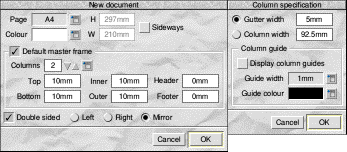
Creating documents and master pages
The first thing to do, when creating a document from scratch, is to define some page characteristics on which your layout will be based. Unlike Impression, Ovation Pro does not have a range of pre-defined master pages already available; instead, you just define the basic features of the page before you start, and from then on you will have one master page per chapter of your document. You can edit the master pages individually at any time, and changes will be reflected in your document.The absence of presets is really no loss. In a sense, Impression's provision of multiple master pages (with facing pages, two-column layouts and so on) was partly to overcome the fact that such layouts were not terribly easy to set up within the program. Ovation Pro has the distinct advantage of supporting multi-column text frames, so master pages with multiple column frames pre-defined are simply not necessary. All these facilities are just options that you can choose when defining the basic characteristics of your document. So, when creating a new document in Ovation Pro, you define the size and format of your page (upright or sideways), choose whether it's double-sided (and if so, whether to define a left, right or mirrored layout), and specify how many columns the frames will have. You can of course set the size of the margins around the frame, and even say whether there should be separate header and footer areas in the master frame. One you've defined your master page in this way, it's very easy to add further elements such as graphics, page numbers or whatever.
The only real shortcoming with Ovation Pro's approach is that the master page for every chapter will be individual, so if you create a multi-chapter document (with all chapters based on identical master pages) and subsequently decide to modify an aspect of the master page layout, you'll have to edit them all individually, which could be a nuisance for larger jobs. In Impression you'd only have to edit a single, named master page for the changes to be reflected in all chapters based on it. So, Ovation Pro does drop a few Brownie points here, but in reality it's not likely to be a major concern for most users.
Of course, you're not obliged to fiddle around with master pages every time you create a new document. If all you want is a standard A4 page then just clicking on the icon on the icon bar will open one up. There's also a handy stationery facility (provided by an extension applet) that allows you to store commonly-used document templates in a submenu off the icon bar menu.
Text handling
Users of other computer platforms still generally think of DTP packages more as layout programs than as word processors, but the term 'document processor', first conjured up to describe Impression, is at least as applicable to Ovation Pro. Powerful DTP package it may be, but it's more than suitable for use as a straightforward word processor as well.As you would expect, Ovation Pro provides a full and comprehensive named text style system, along with equivalent local effects for occasions when defining a style is overkill. The scope of any individual style can be set to apply to a selection, word, line, paragraph or story. Styles can be named freely and reordered in the list, which is useful if you want to group related styles together.
The number of attributes that any style can define is very wide, and ranges from the obvious, expected options like Bold, Italic and Superscript to more obscure ones such as Rotate and Skew (occasionally useful for printing slanted text at an angle, for instance). The style can also set the case of the letters (normal, all caps or every word capitalised), and you can make unexpectedly detailed settings for things like Underline and Strikeout (e.g. single or double lines, word- or continuous-underlining styles, together with colour and rule thickness). Styles can be used to insert drop caps, bullets or numbers at the starts of paragraphs, and there are particularly comprehensive controls for hyphenation and enhanced justification (the latter controlling the use of word- and letter-spacing). Styles also encompass the use of rulers (there is no distinction between rulers and text styles).
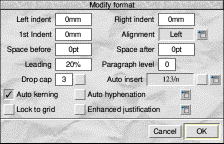
A particularly welcome feature of Ovation Pro (at least, for users of Impression) is that the set of definable options within a text style exactly matches the range of local text effects that the program provides. A great annoyance with Impression, for me at least, was that only a few of the possible style options were available for use as local effects, which often meant that you had to define a new style for a one-off application of a trivial spacing modification, for example. In Ovation Pro, everything that can be accomplished in text styles can also be done with effects. This may encourage a lax approach to styles in some users, but it's still very useful.
So, having said all those positive things about Ovation Pro's text handling facilities, it grieves me to have to point out that there remains one glaring problem in this area of the program's capabilities: it's absolutely hopeless at guessing appropriate weights from fonts with lots of family members, when you use Bold or Italic effects. If you're using a font with only the four standard weights (i.e. regular, italic, bold and bold italic) then clearly there's no problem, but if your font has other weights and styles then you're likely to run into annoying difficulties. If there's an expert set, for example, you might find that it gets selected instead of a plain italic font when you click the Italic button; or you might find a heavy condensed weight being chosen when you click Bold. I do understand the problem here; picking the right font is often quite a tricky thing to do, and no package can hope to guess correctly for every single font family that you throw at it. Nevertheless, Ovation Pro fares unexpectedly badly in this area, which is a pity considering how good it is at nearly everything else. Bold and italic effects are such an everyday requirement that this seemingly minor problem will probably infuriate a lot of people quite regularly.
Frames and drawn objects
Ovation Pro's treatment of frames is one of its more powerful features. By default, frames are rectangular and contain one column. However, they can easily be made elliptical, or the shape of a regular n-sided polygon, or an n-sided star. Alternatively you can create your own frame outlines from a mixture of straight lines and Bezier curves. Frames can then be rotated, and the text they contain still remains editable, even if it's upside down! Any shape of frame can also be made multi-column. Frames can be assigned 'bit-pattern' borders, which you can define yourself; alternatively, rectangular frames can be given Impression-style Draw file borders. Even if you group frames together, it's still possible to edit various attributes of the members of the group; something that Impression users will be pleased to hear, given Impression's restrictions with regard to grouped frames.Ovation Pro also provides some very useful facilities for dealing with the positioning of frames: they can be made to snap to each other, or to guidelines that you place on the page by clicking on rulers at the page border. There are also a couple of grids that objects can snap to: the page grid (similar to the ones found in Draw, ArtWorks etc.) and the text baseline grid, which normally determines the line spacing of any text style that's set to snap to it. There are also some very handy options for creating duplicates of objects at regular intervals, horizontally or vertically, and for aligning and spacing out objects. Taken together, these facilities provide a lot of both precision and flexibility, and allow Ovation Pro to be treated in some respects quite like a drawing package.
There are also some other drawing facilities built into Ovation Pro that further enhance its ability to be used for creating drawings, and which make it very straightforward to draw vector objects of various types: rectangles, ellipses and free shapes comprised of straight lines and Bezier curves. These shapes can all be given line thicknesses, patterns fills, start- and end-caps etc., and can be edited subsequently by stretching, rotating, skewing and so on. Whilst Ovation Pro is not designed to be a drawing package, and its drawing facilities are intended mainly for annotation purposes, or for creating simple page decorations, the fact remains that these features are surprisingly extensive, and there's a lot you can do with them.
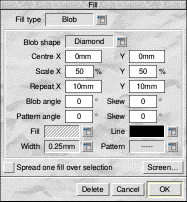
Mention must also be made of the Fill applet, a recent addition to Ovation Pro which allows objects (frames or drawn shapes) to be filled with a variety of fancy effects. You can have various kinds of graduated fill, hatch fills or pattern fills (with drawn patterns that you can define yourself), all with multiple options to affect pattern, colours, angle, skew and so on. Fills can be applied to objects singly or can spread over a range of selected objects.
Graphics
When it comes to importing graphics from external sources, Ovation Pro offers a range of powerful options for image manipulation and processing. The colour model of each image can be set (RGB, CMYK or HSV), its brightness, contrast and gamma settings tweaked, and its printing screen defined. There's also a duotone option which allows you to make an image become monochromatic in a colour scale between two definable colours.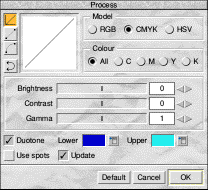
Pictures can be referenced on disc or stored within the document itself, and large graphics files can be represented in the document by proxy images for swifter editing and more efficient memory usage. Needless to say, pictures can be scaled, cropped, rotated, flipped, skewed and stretched, and you can even tile an image over the area of the frame containing it. This works even with irregular frames, and the settings for the picture (scale, skew etc.) can be set differently from those of the frame itself.
All of these features work for both bitmap and vector graphics, and when importing irregular shapes you can even get Ovation Pro to flow text around the graphics automatically (though you can override its attempts if it gets it wrong). There's also a useful option to make spot colours in ArtWorks files behave correctly as spot colours, tying in with equivalently named colours in the Ovation Pro document.
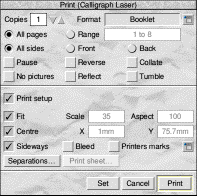
Printing
As you would expect, the printing facilities are comprehensive. As well as standard one-up printing, various other options are provided: pamphlet, galley, printers pairs, booklet, thumbnails and tiles. Some have further sub-options (e.g. the thumbnail option can print different pages or all the same page on one sheet), and all are subject to further definable options, such as page order, fit/scale and so on. Full control is provided over bleed, printers marks and colour separations.As far as I know, these are the most comprehensive printing options available in any RISC OS publishing package, though their layout is sufficiently straightforward that they remain quite easy to use, with almost all of the options confined to a single window.
Customisation
One of the real beauties of Ovation Pro is the extent to which you can customise it and add facilities to it. If you're a programmer type, you can write your own applets to provide completely new facilities, but even if you're not, you can still edit the button bar, create your own macros and so on. It's all very well thought out and powerful.I have to say that I wasn't terribly impressed by the default layout of the button bar across the top of the window. It's a single, scrolling row of buttons and contains a lot of buttons that, to me, don't seem terribly useful, whilst omitting to include some buttons that I'd have liked to be present. But that's no problem: one of the first things I did when starting to use Ovation Pro, a few years ago, was to replace the default button bar with my own more extensive layout. It's very easy to do: just turn on the buttons you want in the Macros window, and then shuffle them around so that they appear where you want them.
The last major modular program for RISC OS was ArtWorks, and of course it was always a great disappointment that very few extra tools were created for ArtWorks (until Martin Würthner came along, at least!). Luckily a similar fate has not befallen Ovation Pro. Large numbers of applets are available for the program, both the ones originally supplied by BEEBUG and new ones created by users, and some of them are extremely useful.
For instance, one particularly handy third party applet allows you to type in some text (or import a Draw file) and then creates a frame from its shape, so it's very easy to create frames which are themselves letters, words or other complex shapes. Other applets provide database facilities, label generation, index generation, typographic controls and many other facilities. Indeed, some of Ovation Pro's most important tools (such as the extensive colour facilities, some of the more advanced printing options and the new fancy-fill tool) are actually applets, though you wouldn't normally want to disable these. They merely go to prove what powerful things applets can do.
You can of course choose just to install the applets that are actually useful to you; many users won't need to type in Hebrew or generate Dutch post codes (and the applet that allows you to play Minesweeper isn't the most productive employment of a DTP package, either)!
Overall
From all of the above, you'll gather that I'm very impressed with Ovation Pro and like it a lot. These observations aren't just based on a brief review; I've been using the package professionally for various purposes since it was launched, and have grown to like it enormously. I liked Impression very much before Ovation Pro arrived, but it has some major limitations, and the big problem with Impression is mainly that development on it ceased years ago. Development continues on Ovation Pro, and it offers a great deal more than Impression from the start.So, if you're an Impression user who's wondering whether to move over to Ovation Pro, I'd strongly advise you to take the plunge. Ovation Pro does far more than Impression, and has a more or less complete superset of Impression's features. OK, there are a few things that Impression still does slightly better (e.g. master pages, as highlighted above, and contents/index generation: there are third-party applets to do similar things in Ovation Pro, but it isn't a native, 'official' function). However, there's really no doubting that Ovation Pro is a very much better product in virtually every way.
Obviously if you're used to using Impression then it'll take you a little while to adjust to the new package, though it's possible to configure various keyboard shortcuts in Ovation Pro to duplicate ones in Impression to ease the transition. As a fairly intensive user of Impression, though, I found the transition much less painful than I had anticipated, and these days I never use Impression for creating new documents; I always start new projects in Ovation Pro. One always has niggles, of course, and there are a few small things that I'd like to see changed in Ovation Pro (e.g. it's a nuisance that the style editor window always opens in the centre of the screen rather than where you last left it, and often covers up what you're looking at!). But the fact is that Ovation Pro works exceedingly well, and I definitely like it a lot more than I liked Impression.
On top of that, combined with the benefits of RISC OS itself (such as its lovely font rendering and the superior way in which the desktop works), I would say that Ovation Pro is more than capable of standing up against any other DTP package on other platforms. It has a nicer user interface than the most recent contender, Adobe InDesign, for example, and far better printing facilities by default. Admittedly InDesign has some advanced facilities that Ovation Pro doesn't offer, but then the reverse is true as well, and on balance Ovation Pro comes out as having far more genuinely useful features as standard than InDesign. I have the latest versions of both packages here, but I invariably choose to use Ovation Pro unless I've a specific reason not to do so, simply because it's the package that I like best and which I find most productive to use. It remains a compellingly good reason to stick with using RISC OS for DTP work.
So, if you have the slightest interest in DTP, this is definitely the package to buy. At £150 for the full package, it's remarkably good value for the functionality it offers. If you're upgrading to the CD, then you should not hesitate to pay the trivial £35 upgrade fee.
It's also worth mentioning the excellent support that's available. There is a very active mailing list for users of Ovation Pro, which is free and easy to join, and David Pilling participates in this list with great regularity. If you have a problem with the package, there's sure to be someone who will be able to help you, and it may even turn out to be the author! Try comparing that with the PC world...
The CD edition
The main purpose of this review is to cover the new CD edition of Ovation Pro, so let's take a look at what you get.
First of all, perhaps it would be pertinent to say what you don't get! If you buy the package from scratch (not having owned it before), you no longer receive the nice big box and printed manual, as that was very expensive packaging that BEEBUG produced several years ago. You just get a CD (in a jewel case with monochrome inlays), and all the software and documentation is provided on it (in Ovation Pro format, of course!). You also no longer get the selection of EFF fonts that used to be supplied; there are some iSV fonts instead. So if you're upgrading from the earlier edition, you have the advantage of a nice box in which to store your new CD, and a few extra fonts!
Although I'm a fan of printed documentation rather than 'virtual' manuals on CD, it's very understandable that the program now just comes on a CD, given the size of the RISC OS market these days. In fact, to be strictly accurate, the program comes on a CD-R: they're created as needed, so you'll always get the latest official release of the application. Your own personal registration code will also be supplied on the CD. The CD originally shipped with version 2.60, but we're now up to version 2.62 (which adds a few useful features), and upgrades are free to download from the Web.
If you do use the BEEBUG version of Ovation Pro already, then this release is an essential purchase. First of all, upgrades are now based on version 2.60 or later (i.e. you need to have bought the CD because the free, downloadable upgrades won't work on versions of Ovation Pro prior to 2.60); and also, a new level of document compatibility has been introduced with version 2.60. That is, documents saved from version 2.60 can't be loaded into earlier versions. So, if you're an existing user, you'd be very ill-advised not to upgrade to the CD.
On the CD
Opening the CD's root directory reveals a !RunMe application and a couple of Zip archives entitled iSV and OvationPro. Running the application launches Ovation Pro from the CD and opens a window on its archive. The entire contents of the CD are thus archived, which is useful because it allows the use of mixed-case filenames without any compatibility worries about versions of CDFS and so on.The iSV archive just contains a copy of iSV Products' Web site and a selection of demo applications, so I won't say any more about that archive here. All the rest of what I have to say relates to the contents of the main Ovation Pro archive.
Organisation of the CD
The archive is divided into two main subdivisions: David Pilling's software and contributions from other people. The former directory is of course where all the most important software and documentation is provided, and it contains the following elements:- Web site: a copy of David Pilling's Web site, complete with software upgrades and free applications
- Applets: the collection of nearly 50 extension applets supplied 'officially' with Ovation Pro
- Clip-art: a selection of DEC_dATA clip-art, divided into thirteen categories
- Documentation: complete documentation for the software and contents of the CD
- Extras: a collection of miscellaneous supplemental resources and applications
- Filters: utilities to allow various foreign file formats to be loaded into Ovation Pro
- Fonts: a selection of fonts from Acorn (two symbol fonts), BEEBUG (four families) and iSV (20 families)
- Mailing list: a complete record of the Ovation Pro mailing list, dating back to 1996
- Ovation Pro: the application itself
Many of these items, such as the applets, filters and clip-art, were supplied previously on the BEEBUG edition, though obviously some of the software has been revised and updated. However, there's plenty of things that are new to the CD. The presence of the complete documentation is a bonus, especially because the fact that it's in Ovation Pro format makes it somewhat easier to search. As well as the full manual, there is also a tutorial, a guide to the contents of the CD, a guide to the scripting language and a handy reference document, all in new editions. To be frank, I found a number of small errors in various documents and felt that the proof-checking could have been slightly better, but on the whole the documents are well produced and certainly provide all the information you could require.
On the subject of information, the mailing list archive is quite a valuable addition. Admittedly it's not the easiest reference to use because it reflects chronological discussions that took place over the Internet. However, there's a large body of information which you can search using any old text editor, or Ovation Pro itself. The messages from the list are saved in groups of one file per month, starting in September 1996.
The Extras directory contains a number of handy additions. A third party applet manager makes it easier to organise your applets and check their version numbers, and the popular BubbleHelp application provides a nicer pop-up help system than that built into RISC OS 4. There's a colour calibration utility, a few example documents showing off specific features of Ovation Pro, and a utility to produce a directory catalogue in tab-separated format, suitable for importing into a DTP document. There are macros to set up a 'junior' version of Ovation Pro, or to make its keyboard shortcuts compatible with those of Impression. There's a resource directory in which you can store your own custom extensions to the dictionary, and, perhaps most usefully, there's a full copy of BEEBUG's handy Desktop Thesaurus package, which includes both synonyms and antonyms.
Filters and singing horses
The filters, which allow foreign file formats to be loaded into Ovation Pro, include translation for Impression DDF files, graphics files (via ChangeFSI), PhotoCD images, RTF (rich text format) text and, finally, Impression documents. The Impression document translator is one of the touted new features of the CD edition, so it's worth a few words here.As the old saying goes, the remarkable thing about a singing horse is not that it sings well, but that it sings at all. The same might be said about Ovation Pro's Impression file loader. The point is that, despite having shown no signs of developing Impression any further for several years, Computer Concepts has unfortunately proved unwilling to supply any details of its file format, and so it was necessary for David Pilling to deduce what he could of the format in order to write the translator.
The end result is a loader which works, but which does not currently do its job quite as well as might be hoped. Various things do not work properly; for example, borders in the Impression document will not make their way across, some styles will appear slightly incorrect, tinted colours may come out solid, various aspects of the line spacing may not be the same, and so on. The problems are also compounded by Ovation Pro's annoying shortcomings when it comes to choosing appropriate fonts for italic and bold text. For example, I tried translating one document and found that several words had apparently gone missing in the middle of sentences. In fact they were still there, but Ovation Pro was picking an italic expert set rather than a regular italic font for italicised text, and in this particular expert set, most of the regular letters were not defined; hence the words disappeared!
But of course all the styles, frames, text and graphics should be imported and can then be edited quite quickly to get the document into shape again. The loader can also cope with both single-file and application-format Impression documents, so that's very useful in terms of broad compatibility. It's slightly disappointing that there isn't more 'instant gratification' in terms of your Impression document continuing to look exactly the same in Ovation Pro as it did in Impression; but (under the circumstances, particularly) the conversion is still fairly impressive.
So, that's why I mentioned singing horses at the outset. When using this converter, you should not expect miracles as you won't get them. However, what you will get is a document that needs only a relatively small amount of tweaking before it's perfectly acceptable. It's far better to have the loader in its current form than to have to recreate all your Impression documents from scratch. Also, of course, this is only the first release of the loader. It's quite possible that it will improve over time.
Below is an example of a converted Impression document. It's a pair of facing pages from a book that was printed from camera-ready copy by Collins a few years ago. The left-hand image is the original document, with the Ovation Pro conversion to the right. These are actually the second and third pages of the book, and as you can see the text has flowed slightly differently even at the start of page 2, so there will be quite a large variance by the end of the document. Nevertheless, the quality of the conversion is very creditable, and it would not take long at all to put these problems right.
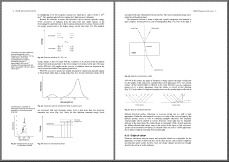 | 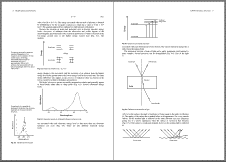 |
| (Click the images to see them at full size) | |
New features in Ovation Pro
The last official release of Ovation Pro from BEEBUG Ltd was version 2.52. Now, it's true that there have been quite a lot of intermediate upgrades since then, and if you've been installing them as they've become available, ending up with (probably) version 2.58, then you won't find that very much has changed in the CD release. However, taken overall, quite a lot of important new features have been added since version 2.52, so for the benefit of readers who haven't upgraded from that version, some of the more important recent additions are:- New Fill applet: this allows frames and drawn objects to be filled with graduated fills, repeating patterns or hatching in an extremely flexible way.
- Support for savers: Ovation Pro now supports modular export plug-ins as well as import filters. This is a very new feature (version 2.61), so no plug-ins are available yet, but it would theoretically allow Ovation Pro to export Word files, HTML pages, QuarkXPress documents or whatever other formats might be useful.
- Bullets and automatic numbers: there is now in-style support for automatically numbered or bulleted paragraphs
- 'Tumble' printing: when enabled, Tumble printing causes reverse-side pages to be printed upside down, which is useful, for example, if you want to print something on a card to be folded over rather than being printed double-sided.
- Tiled graphics: images can be tiled within their parent frames.
- Non-printing colours: any colour can now be made not to print; very useful for leaving instructions or annotations on a document without having to worry about removing them all prior to printing.
- Multiple clipboards: Ovation Pro now supports up to ten clipboards, which can be very handy for cutting and pasting several often-repeated items.
- Movable chapters: entire chapters can be shifted around a document by copying and pasting.
- Proxy images: low-resolution preview versions of individual pictures can be made to appear in a document rather than the full memory-hungry graphics.
- ...and, of course, lots of bug-fixes.
The above is just a selection; there are plenty of other improvements and new features of a more minor nature (and probably some major ones that I've missed!).
Other material on the CD
Within the 'Others' directory on the CD (i.e. the non-David Pilling software archive) can be found a wide range of material from a total of around thirty contributors. These include roughly forty additional applets, extra resource material, sixteen useful articles from RISC User magazine and a couple from Acorn User, and a certain amount of extra software, some of it demonstration-only, some of it fully functional.The extra applets, in particular, are in some cases very useful, and a few of them provide enhanced versions of applets supplied 'officially' with the program.
The organisation of these materials is on a 'by surname' basis, and hence could in some ways be a bit more useful. However, the resources provided are listed in their entirety (with appropriate explanatory details) in the CD guide document, so it's easy to find something specific without having to hunt through all the directories.
Summary
To sum up, Ovation Pro itself is an absolutely superb package, and without question by far the best DTP software you can buy for RISC OS. I personally consider it my favourite DTP package on any platform, even when compared with the latest versions of the heavyweights. All DTP packages have their own strengths and weaknesses, of course, and I'm not saying that Ovation Pro is a QuarkXPress- or InDesign-killer; but equally well, those packages are in some ways inferior to Ovation Pro. What I'm saying is that Ovation Pro can stand comparison with them and emerge with numerous advantages, and its combination of great power and flexibility with an excellent user interface makes it a real winner.As for the CD release, it combines virtually all of the various resources for Ovation Pro that are available on the Internet in a single convenient place, along with new items and useful reference material, and it's all pretty well organised into the bargain.
So, if you don't have Ovation Pro already, you should definitely buy it without hesitation. And if you have an earlier version but have not yet decided to upgrade to the CD release, then wait no longer. However you buy it, it's money well spent.
Conclusions
Product details
| Product: | Ovation PRO CD |
| Supplier: | David Pilling |
| Price: | £150 fully inclusive (single user), £300 fully inclusive (site licence) |
| Upgrade: | from £35 depending on the version you already have. |
| Address: | PO BOX 22, Thornton Cleveleys, Blackpool, FY5 1LR |
| Fax: | 0870 0520941 |
| WWW: | http://www.pilling.demon.co.uk |
| E-mail: |
If upgrading from the BEEBUG edition, please supply the full address under which your old copy was registered, your new registration address (if different), and your serial number.
Geoffrey Dean